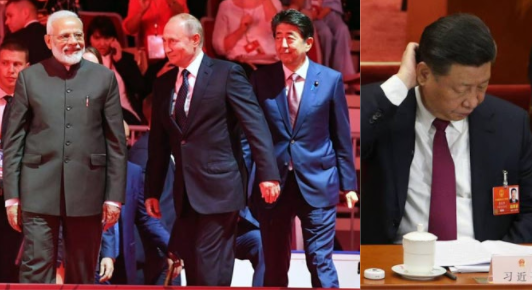As India and China fight it out in the icy Himalayan heights, New Delhi has already started encircling Beijing in the Indo-Pacific. India is enhancing cooperation with Japan and Russia to marginalise China in its vicinity.
In two major blows to China, India has inked a Mutual Logistics Support Agreement (MLSA) with Japan and has also started working towards a similar Mutual Defence Logistics Support Agreement with Russia. The Russian Deputy Chief of Mission (DCM), Roman Babushkin, on Tuesday said that New Delhi and Moscow could ink the logistics sharing pact during the Indo-Russian bilateral summit in October or November.
The latest developments are a part of India’s bid to corner China in its own backyard. India has signed military logistics support agreements with many Pacific powers surrounding China, including the United States, South Korea, Singapore and Australia.
These logistics sharing pacts are a major force multiplier when it comes to military and maritime cooperation. By finalising pacts with a number of countries in the region, Indian warships now have the option of availing and refuelling facilities in bases located around all of China’s conflict zones in the Western Pacific, including the South China Sea, the East China Sea and the Yellow Sea. Military logistics pact with Russia and Japan however complete India’s bid to encircle the Chinese PLA Navy from all sides.
As far as Japan is concerned, the inking of the Mutual Logistics Support Agreement (MLSA) is symbolic of how New Delhi and Tokyo continue to be close allies even as India’s friend, Japanese PM Shinzo Abe calls it quits. Abe is however giving a parting gift of sorts to New Delhi. The logistics sharing pact could as well become the forerunner of a formal, two-front military alliance between India and Japan against China. After all, New Delhi and Tokyo are the only QUAD members who actually share hostilities with China, and have a shared interest in checking the gigantic bully.
Made a phone call to my dear friend @AbeShinzo to wish him good health and happiness. I deeply cherish our long association. His leadership and commitment have been vital in taking India-Japan partnership to new heights. I am sure this momentum will continue in the coming years.
— Narendra Modi (@narendramodi) September 10, 2020
Similarly, a likely Defence Logistics Support Agreement between India and Russia is a statement of intent coming from Moscow. Notably, India and Russia are heading closer at a time when Russia is hosting both China and India at the Shanghai Cooperation Organisation (SCO) meeting of the Council of Foreign Ministers (CFM).
Also, we cannot miss how Russia has chosen India at a time when both India and China are locked in unprecedented border skirmishes. Russian President Vladimir Putin has his own reason to choose India over China. Russia’s interests militate against Chinese hegemony in the Indo-Pacific, including the Western Pacific.
Only recently, India had nudged Russia to look towards its own interests in the Indo-Pacific region. Moreover, China had shot itself in the foot by staking claim over the Russian Far East city of Vladivostok. The Chinese aggression and Indian cooperation have compelled Putin to help New Delhi in marginalising China through a logistics support pact between India and Russia.
It is now becoming clearer that India’s maritime strategy is going to be aligned more and more with a counter-offensive strategy. India is not only going to neutralise Chinese presence in the Indian Ocean Region (IOR) but is also going to breath down the Dragon’s neck in the Indo-Pacific.
And this isn’t about India’s Logistics Support Agreement with like-minded allies alone, as New Delhi is also building ports at strategic locations to put Beijing in its place. Take for example the deep seaport that India is developing in Indonesia’s Sabang. This port will be located merely 500 kilometres away from the Strait of Malacca– a narrow stretch of water dividing the Indian and Pacific Oceans, handling 80 per cent of China’s oil supplies.
Similarly, India is building the Sittwe port in Myanmar close to China’s Kyaukpyu port project. And therefore, India is not letting China have its way when it comes to augmenting maritime influence in the Association of Southeast Nations (ASEAN). India’s strategy of building close alliances based on mutual trust as against China’s “debt-trap” diplomacy of usurping ports is clearly doing the trick.
India had already gained a lot of presence in China’s backyard. But now by inking an MLSA with Japan and moving ahead towards a defence logistics support pact with Russia, India has made some deep inroads in its competition for influence with China within the Indo-Pacific. Ultimately, New Delhi is going to cut the Dragon to size. China’s salami-slicing tactics in the Himalayas can at best serve the Communist hardliners in Beijing, but when it comes to real power projection in the maritime-oriented Indo-Pacific, New Delhi is clearly winning the game.


































